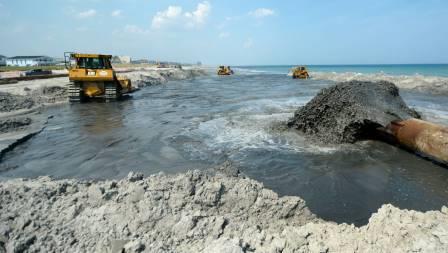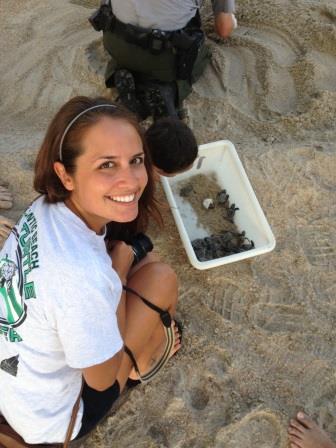Kimberly Hernandez completed her master’s degree in coastal environmental management and certificate of geospatial analysis from Duke University in May 2014. She currently is a NOAA Coastal Management Fellow with the Maryland Department of Natural Resources Chesapeake and Coastal Service in Annapolis. Hernandez is working with state and regional partners to improve the integration of stakeholder feedback and scientific data into coastal decision making. She focuses on understanding the role that humans play in how ecosystems function and are managed, and works to weave climate-change preparedness into that relationship. A native of Kansas, Hernandez earned her undergraduate degrees in environmental studies and international studies from the University of Kansas.
What is the relationship between beach nourishment and sea turtle protection in North Carolina? During my time as a fellow, I examined and attempted to characterize this connection.
Beach nourishment — also called beach replenishment, renourishment or beach fill — is the process of placing sand onto an eroded beach in order to widen the beach. Because of the economic value of coastal property and limitations on seawalls, groins and other hard structures on North Carolina beaches, beach nourishment is a widespread solution to combat eroding shorelines.
But, with the coast changing and beachfront development continuing, beach visitors could expect to see beaches thin as they are increasingly squeezed by rising tides, storm surges and coastal development. My research assumed that the demand for beach nourishment will at least continue, if not increase, in the future in order to protect coastal property.
The 2011 N.C. Beach and Inlet Management Plan, conducted by the N.C. Division of Coastal Management, estimated an economic loss of $408 million should the state lose half its beaches. This scenario is not likely to happen, given the investments by government and private entities to protect beachfront property and public beaches.
The incentives to protect beaches — and the private properties behind them — are worth noting. With the U.S. Army Corps of Engineers and DCM prioritizing nourishment as a viable and effective option to safeguard beaches, it is important to understand the full range of implications for both sea turtles and people before a project is permitted.
Of the seven species of sea turtles worldwide, four — loggerhead, green, leatherback and Kemp’s ridley — are commonly found in North Carolina waters. My research focused exclusively on the federally threatened loggerhead sea turtle, the species most likely to be found nesting on North Carolina beaches.
Female sea turtles tend to return to the same region in which they hatched, meaning that loss or modification of these nesting beaches could affect the future loggerhead population. On North Carolina beaches, two main threats to sea turtles exist: sea-level rise, and human disturbance, such as beachfront construction, dredging, driving or beach lights.
There are more than 20 sea turtle volunteer groups across the state that monitor and protect nesting beaches and hatchlings. In addition, they observe nesting beaches for any changes after beach nourishment, and help scientists and town planners further understand how modified beaches affect loggerhead sea turtles.
In July 2014, the U.S. Fish and Wildlife Service designated 96.1 miles of North Carolina ocean beaches as critical habitat for nesting loggerheads.
I selected some of these areas for my research — Bogue Banks in Carteret County; Pleasure Island in New Hanover County; and Bald Head Island, Oak Island and Holden Beach in Brunswick County. I chose these locations because of their critical habitat designation and because of their vulnerability to sea-level rise based on historical U.S. Geological Survey data and future predictions. These islands also have a long history of beach nourishment.
PROTECTING TURTLES
After months of research and conversations with stakeholders — including the Carteret County and New Hanover County shore-protection offices, the N.C. Wildlife Resources Commission, and DCM — my final recommendations include a series of suggestions that could help North Carolina make ecologically responsible and sustainable decisions with regard to the management of our beachfronts and sea turtles.
I highlight two recommendations here: the value of incorporating sand color into the sediment criteria rules; and the importance of maintaining the dredging/nourishment windows.

The current state rules governing the quality of sediment placed on a beach — the Technical Standards for Beach Fill, also known as the sediment criteria rules — do not specify sediment color. This may be a critical oversight because the sex of a sea turtle is determined by sand temperature inside the nest.
Incubation on darker/warmer beaches is more likely to produce females. Nests incubated on lighter/cooler beaches, such as those native to North Carolina, tend to result in a more even mix of males and females.
While North Carolina does not boast the volume of nests of, say, Florida, the turtles that do nest here are important to maintain the population’s sex ratio. Based on 26 years of data, scientists from the United Kingdom and North Carolina found that 42 percent of the hatchlings from North Carolina beaches are male, compared to 10 percent of those from Florida beaches.
Altering sand color in the nourishment process may have negative long-term impacts on the population dynamics of loggerheads.
Next, in North Carolina, suggested environmental windows dictate when nourishment should take place in order to avoid negative impacts to sea turtles. Some argue that these windows should be extended for economic reasons. They contend that added scheduling flexibility would drive up competition among dredging companies, resulting in cheaper projects.
However, data show that dredging during these times does protect the turtles. From 1992 to 2006, only one sea turtle was killed during dredging in the Morehead City vicinity during the Jan. 1 to March 31 window, while 20 sea turtles were killed while dredging outside of this window.
Long-term solutions to protecting North Carolina’s beaches, and threatened and endangered sea turtles that use these areas, will not be easy to develop or implement.
Doing so will require the buy-in of many stakeholders, but such cooperative planning is necessary to ensure a vibrant coastline long into the future.
Investing in policies and legislation designed to protect beaches — and sea turtles — not only will yield positive ecological advantages, but also will benefit the tourism industry, coastal landowners and the general public for generations to come.
For Hernandez’s full report, contact Lisa Schiavinato at lisa_schiavinato@ncsu.edu.
This article was published in the Holiday 2014 issue of Coastwatch.
- Categories:



